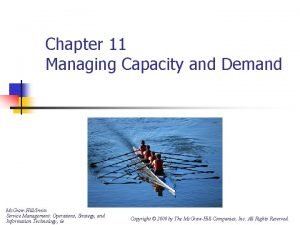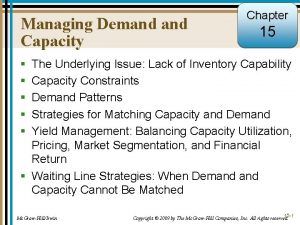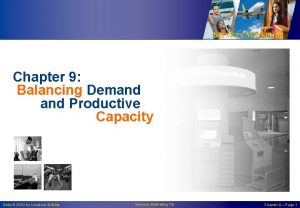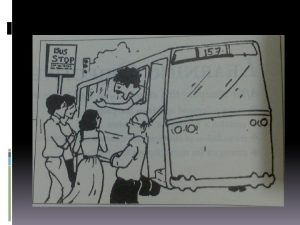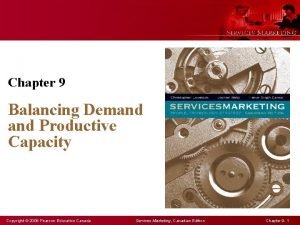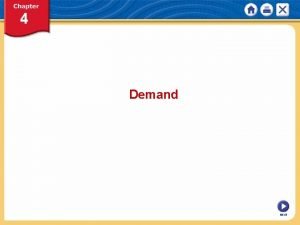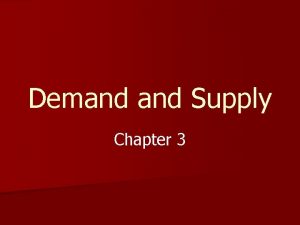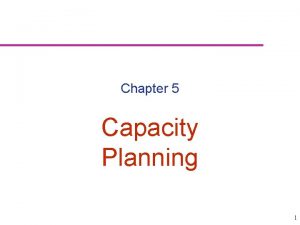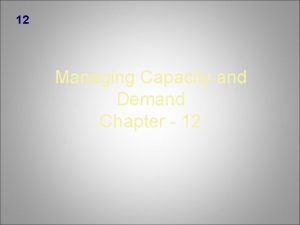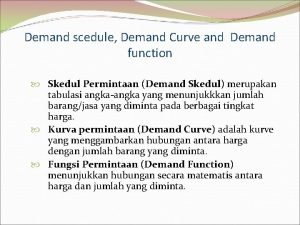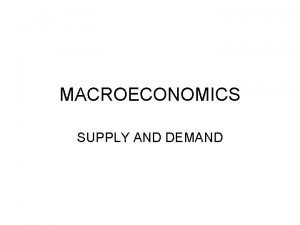Chapter 11 Managing Capacity and Demand Mc GrawHillIrwin
















- Slides: 16

Chapter 11 Managing Capacity and Demand Mc. Graw-Hill/Irwin Service Management: Operations, Strategy, and Information Technology, 6 e Copyright © 2008 by The Mc. Graw-Hill Companies, Inc. All Rights Reserved.

Learning Objectives n n n Describe the strategies for matching capacity and demand for services. Recommend an overbooking strategy. Use Linear Programming to prepare a weekly workshift schedule. Prepare a work schedule for part-time employees. Explain what yield management is and how it is applied. 11 -2

Level Capacity and Chase Demand Strategic Dimension Level Capacity Chase Demand Customer Waiting Generally Low Moderate Employee Utilization Moderate High Labor-skill Level High Low Labor Turnover Low High Training Required per Employee High Low Working Conditions Pleasant Hectic Supervision Required Low High Long-run Short-run Forecasting 11 -3

Strategies for Matching Capacity and Demand for Services MANAGING DEMAND Developing complementary services Developing reservation systems MANAGING CAPACITY Partitioning demand Sharing capacity Establishing price incentives Crosstraining employees Promoting off-peak demand Using part-time employees Yield management Increasing customer participation Scheduling work shifts Creating adjustable capacity 11 -4

Customer-induced Variability n n n Arrival: customer arrivals are independent decisions not evenly spaced. Capability: level of knowledge and skills vary resulting in some hand-holding. Request: uneven service times result from unique demands. Effort: level of commitment to coproduction or self-service varies. Subjective Preference: personal preferences introduce unpredictability. 11 -5

Segmenting Demand at a Health Clinic Smoothing Demand by Appointment Scheduling Day Monday Tuesday Wednesday Thursday Friday Appointments 84 89 124 129 114 11 -6

Discriminatory Pricing for Camping Experience Type 1 2 3 4 Days and weeks of camping season Saturdays and Sundays of weeks 10 to 15, plus Dominion Day and civic holidays Saturdays and Sundays of weeks 3 to 9 and 15 to 19, plus Victoria Day Fridays of weeks 3 to 15, plus all other days of weeks 9 to 15 that are not in experience type 1 or 2 Rest of camping season No. of Days 14 Daily Fee $6. 00 23 2. 50 43 0. 50 78 free EXISTING REVENUE VS PROJECTED REVENUE FROM DISCRIMINATORY PRICING Experience Type 1 2 3 4 Total Existing flat fee of $2. 50 Campsites occupied Revenue 5. 891 $14, 727 8, 978 22, 445 6, 129 15, 322 4, 979 12, 447 25, 977 $ 64, 941 Discriminatory fee Campsites occupied (est. ) Revenue 5, 000 $30, 000 8, 500 21, 250 15, 500 7. 750 …. …. 29, 000 $59, 000 11 -7

Hotel Overbooking Loss Table Number of Reservations Overbooked No. Probshows ability 0 0. 07 0 1. 19 40 2. 22 80 3. 16 120 4. 12 160 5. 10 200 6. 07 240 7. 04 280 8. 02 320 9. 01 360 Expected loss, $ 121. 60 1 100 0 40 80 120 160 200 240 280 320 91. 40 2 200 100 0 40 80 120 160 200 240 280 87. 80 3 300 200 100 0 40 80 120 160 200 240 115. 00 4 5 6 400 500 600 300 400 500 200 300 400 100 200 300 0 100 200 40 0 100 80 40 0 120 80 40 160 120 80 200 160 120 164. 60 231. 00 311. 40 7 8 700 800 600 700 500 600 400 500 300 400 200 300 100 200 0 100 40 0 80 40 401. 60 497. 40 9 900 800 700 600 500 400 300 200 100 0 560. 00 11 -8

Yield Management Using the Critical Fractile Model Where x = seats reserved for full-fare passengers d = demand for full-fare tickets p = proportion of economizing (discount) passengers Cu = lost revenue associated with reserving one too few seats at full fare (underestimating demand). The lost opportunity is the difference between the fares (F-D) assuming a passenger, willing to pay full-fare (F), purchased a seat at the discount (D) price. Co = cost of reserving one to many seats for sale at full-fare (overestimating demand). Assume the empty full-fare seat would have been sold at the discount price. However, Co takes on two values, depending on the buying behavior of the passenger who would have purchased the seat if not reserved for full-fare. if an economizing passenger if a full fare passenger (marginal gain) Expected value of Co = p. D-(1 -p)(F-D) = p. F - (F-D) 11 -9

Daily Scheduling of Telephone Operator Workshifts Topline profile Scheduler program assigns tours so that the number of operators present each half hour adds up to the number required Tour 12 2 4 6 8 10 12 11 -10

LP Model for Weekly Workshift Schedule with Two Days-off Constraint Schedule matrix, x = day off Nurse 1 2 3 4 5 6 7 8 Total Required Excess Su x … … … x 6 3 3 M x x. . . … … 6 6 0 Tu … x x x … … 5 5 0 W … … x x … … 6 6 0 Th … … x x x … 5 5 0 F … … x x x … 5 5 0 Sa. . . … … … x 7 5 2 11 -11

Tellers required 2 3 4 5 6 7 Scheduling Part-time Bank Tellers required 0 1 2 3 4 5 Decreasing part-time teller demand histogram 0 1 Two Full-time Tellers Mon. Tues. Wed. Thurs. 5 4 3 2 1 1 5 2 Fri. Mon. Wed. Thurs Tues. Fri. DAILY PART-TIME WORK SCHEDULE, X=workday Teller 1 2 3, 4 5 Mon. x x x …. Tues. …. …. Wed. x …. …. x Thurs. …. x …. …. Fri. x x 11 -12

Ideal Characteristics for Yield Management n n n Relatively Fixed Capacity Ability to Segment Markets Perishable Inventory Product Sold in Advance Fluctuating Demand Low Marginal Sales Cost and High Capacity Change Cost 11 -13

Percentage of capacity allocated to different service classes Seasonal Allocation of Rooms by Service Class for Resort Hotel First class Standard Budget 30% 20% 50% 20% 30% 20% 50% 60% 10% Peak (30%) Summer 30% Shoulder (20%) Fall 50% Off-peak (40%) Winter 30% Shoulder (10%) Spring Percentage of capacity allocated to different seasons 11 -14

Demand Control Chart for a Hotel Expected Reservation Accumulation 2 standard deviation control limits 11 -15

Topics for Discussion n n What organizational problems can arise from the use of part-time employees? How can computer-based reservation systems increase service capacity utilization? What possible dangers are associated with developing complementary services? Will the widespread use of yield management eventually erode the concept of fixed prices? 11 -16
 Chase demand strategy
Chase demand strategy Managing demand and capacity
Managing demand and capacity Production units have an optimal rate of output where
Production units have an optimal rate of output where Module 5 supply and demand introduction and demand
Module 5 supply and demand introduction and demand Balancing demand and productive capacity
Balancing demand and productive capacity Balancing demand and capacity
Balancing demand and capacity Alternative times
Alternative times Demand management and capacity management
Demand management and capacity management Balancing demand and productive capacity
Balancing demand and productive capacity Measures to correct excess demand and deficient demand
Measures to correct excess demand and deficient demand Independent vs dependent demand
Independent vs dependent demand Kagustuhan+kakayahan=demand
Kagustuhan+kakayahan=demand What is demand estimation in managerial economics
What is demand estimation in managerial economics Distinguish between individual demand and market demand
Distinguish between individual demand and market demand Independent demand and dependent demand
Independent demand and dependent demand Alternative capacity plans
Alternative capacity plans Deterministic demand vs stochastic demand
Deterministic demand vs stochastic demand
